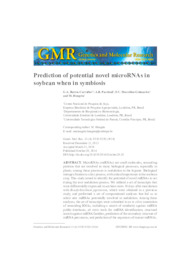Prediction of potential novel microRNAs in soybean when in symbiosis.
Prediction of potential novel microRNAs in soybean when in symbiosis.
Autoria: BARROS-CARVALHO, G. A.; PASCHOAL, A. R.; MARCELINO-GUIMARÃES, F. C.; HUNGRIA, M.
Resumo: MicroRNAs (miRNAs) are small molecules, noncoding proteins that are involved in many biological processes, especially in plants; among these processes is nodulation in the legume. Biological nitrogen fixation is a key process, with critical importance to the soybean crop. This study aimed to identify the potential of novel miRNAs to act during the root nodulation process. We utilized a set of transcripts that were differentially expressed in soybean roots 10 days after inoculation with Bradyrhizobium japonicum, which were obtained in a previous study, and performed a set of computational analyses that led us to select new miRNAs potentially involved in nodulation. Among these analyses, the set of transcripts were submitted to an in silico annotation of noncoding RNAs, including a search of similarity against miRNA public databases, ab initio tools for miRNA identification, structural search against miRNA families, prediction of the secondary structure of miRNA precursors, and prediction of the sequences of mature miRNAs. Subsequently, we applied filter procedures based on miRNA selections described in the literature (e.g., free energy value). In the next step, a manual curation inspection of the annotation was performed and the top candidates were selected and used for prediction of potential target genes, which were later checked manually in the database of the soybean genome. This prediction led us to the identification of 9 potential new miRNAs; among these, 4 were conserved in other plants. Moreover, we predicted their target genes might play important roles in the regulation of nodulation.
Ano de publicação: 2014
Tipo de publicação: Artigo de periódico
Unidade: Embrapa Soja
Palavras-chave: Soja
Observações
1 - Por padrão são exibidas publicações dos últimos 20 anos. Para encontrar publicações mais antigas, configure o filtro ano de publicação, colocando o ano a partir do qual você deseja encontrar publicações. O filtro está na coluna da esquerda na busca acima.
2 - Para ler algumas publicações da Embrapa (apenas as que estão em formato ePub), é necessário ter, no celular ou computador, um desses softwares gratuitos. Sistemas Android: Google Play Livros; IOS: iBooks; Windows e Linux: software Calibre.
Acesse outras publicações
Acesse a Base de Dados da Pesquisa Agropecuária (BDPA) para consultar o acervo completo das bibliotecas da Embrapa.

